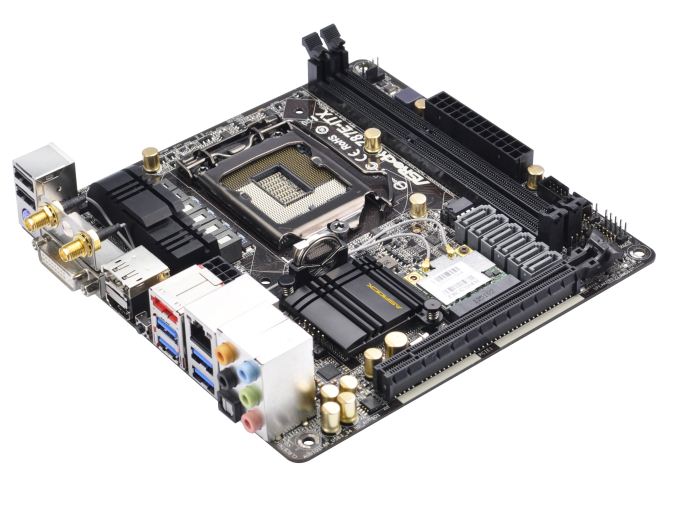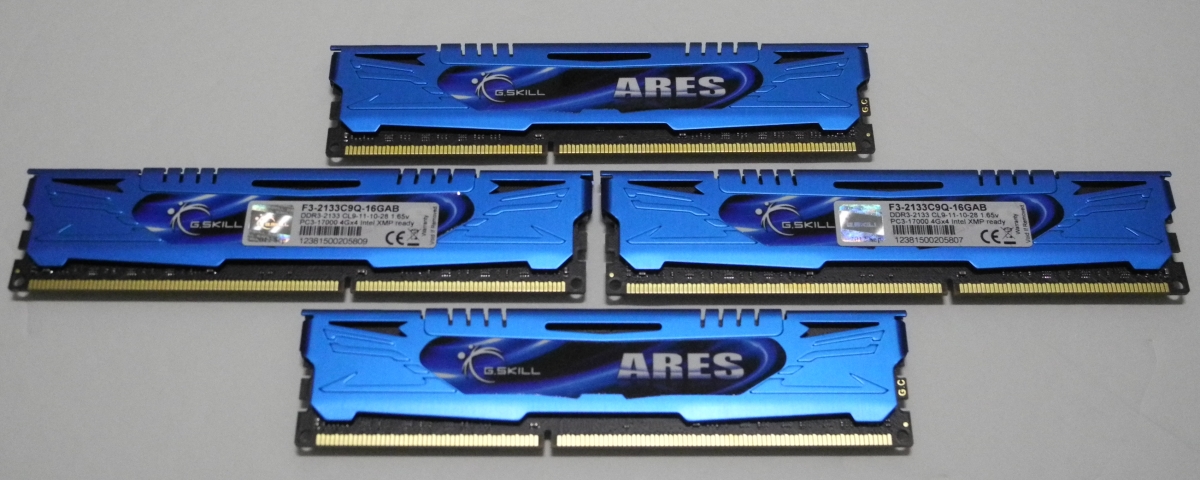Intel's Haswell - An HTPC Perspective: Media Playback, 4K and QuickSync Evaluated
by Ganesh T S on June 2, 2013 8:15 PM ESTTestbed and Software Setup
Instead of going for the usual high end CPU (77W / 95W TDPs), we have opted for the Core i7-4765T for today's review. This is a 35W TDP CPU with four cores / eight threads, expected to retail with a MSRP of $303. Intel has a number of GPU configurations doing the rounds at Haswell launch. The i7-4765T sports the HD 4600 GPU, and it is the best GPU available in a LGA 1150 configuration (The Iris Pro 5200 GPUs are reserved for BGA configurations and unavailable to system builders).
The table below presents the hardware components of our Haswell HTPC testbed
| Haswell HTPC Testbed Setup | |
| Processor | Intel Core i7-4765T - 2.00 GHz (Turbo to 3.0 GHz) |
| Intel HD Graphics HD4600 - Up to 1200 MHz | |
| Motherboard | ASRock Z87E-ITX mITX |
| OS Drive | Seagate 600 SSD ST240HM000 240GB |
| Memory | G.SKILL Ares Series 8GB (2 x 4GB) SDRAM DDR3 2133 (PC3 17000) F3-2133C9Q-16GAB CAS 9-11 -10-28 2N |
| Optical Drive | ASUS 8X Blu-ray Drive Model BC-08B1ST |
| Case | Antec Skeleton ATX Open Air Case |
| Power Supply | Antec VP-450 450W ATX |
| Operating System | Windows 8 Professional x64 |
| Displays / AVRs | Onkyo TX-SR606 + Acer H243H |
| Pioneer Elite VSX-32 + Sony Bravia KDL46EX720 | |
| Sony XBR-84X900 | |
| Seiki Digital SE50UY04 | |
The ASRock Z87E-ITX board comes with a Broadcom-based 802.11ac 2T2R solution. Connected to a Buffalo WZR-D1800H 802.11ac router, I was able to consistently obtain 173 Mbps of practical throughput. Streaming Blu-ray ISOs over Wi-Fi from a NAS worked without issues. The board was very simple to get up and running and given its form factor and the CPU currently installed, I hope to migrate it to a passive HTPC build soon.
The Haswell platform officially supports DDR3-1600. Towards this, we obtained a 16 GB DDR3-2133 Ares kit from G.Skill for our testbed. The Ares kit supports XMP 1.2 and the ASRock Z87E-ITX had it running at 2133 MHz flawlessly on first boot. However, we made sure to run the memory at the suggested 1600 MHz in order to obtain results consistent with what an average system builder (non-overclocker) would obtain. The Ares kit makes it possible to study HTPC behaviour from a memory bandwidth perspective, but we will not cover that aspect in this launch piece.
The software setup for the Haswell HTPC testbed involved the following:
| Haswell HTPC Testbed Software Setup | |
| Intel Graphics Driver | 9.18.10.3107 (Version on ASRock Motherboard DVD) |
| Blu-ray Playback Software | CyberLink PowerDVD 13 |
| Media Player | MPC-HC v1.6.7.7114 |
| Splitter / Decoder | LAV Filters 0.57 |
| Renderers | EVR / EVR-CP (integrated in MPC-HC v1.6.7.7114) |
| madVR v0.86.1 | |
The madVR renderer settings were fixed as below for testing purposes:
- Decoding features disabled
-
Deinterlacing set to:
- automatically activated when needed (activate when in doubt)
- automatic source type detection (i.e, disable automatic source type detection is left unchecked)
- only look at pixels in the frame center
-
Scaling algorithms were set as below:
- Chroma upscaling set to SoftCubic with softness of 100
- Luma upscaling set to Lanczos with 4 taps with anti-ringing filter left deactivated and scale in linear light left unchecked / DXVA2
- Luma downscaling set to Lanczos with 4 taps with anti-ringing filter left deactivated and scale in linear light left unchecked / DXVA2
-
Rendering parameters were set as below:
- Automatic fullscreen exclusive mode was used
- CPU and GPU queue sizes were set to 32 and 24 respectively
- Under exclusive mode settings, the seek bar was enabled, switch to exclusive mode from windowed mode was delayed by 3 seconds and 16 frames were configured to be presented in advance. The GPU flushing modes were set to default
- Smooth motion was left disabled
- The 'trade quality for performance' settings were left at default (i.e, linear light was left disabled for smooth motion frame blending and custom pixel shader results were stored in 16-bit buffers instead of 32-bit)
Unlike our Ivy Bridge setup, we found the windowed mode to be generally bad in terms of performance compared to exclusive mode.
MPC-HC and LAV Filters settings were altered from the defaults as below for testing purposes:
- DirectShow Video Output was configured as EVR / EVR-CP / madVR under Options > Playback > Output
- All internal source and transform filters were disabled under Options > Internal Filters
- Under Options > External Filters, LAV Splitter, LAV Audio Decoder and LAV Video Decoder were added as Preferred filters
- LAV Audio Decoder was set to bitstream all applicable formats
-
LAV Video Decoder were altered from the defaults as below
- Hardware Acceleration was set to DXVA2 Native / QuickSync / None depending on the aspect being tested. UHD (4K) was enabled in all the cases
- Deinterlacing mode was set to 'Aggressive'












95 Comments
View All Comments
Penti - Monday, June 3, 2013 - link
Plus old hardware is old and not available anymore.phoenix_rizzen - Monday, June 3, 2013 - link
Quad-core Athlon-II, CPU fan configured to spin down as needed, case fan unplugged, SSD, nVidia 210 GPU (fanless) running Linux + XBMC. Sub-$300 CDN.Why would you need an i7 for an HTPC? Why would you need a skookum dGPU? And why would you be transcoding on the HTPC? The HTPC should just play the movies on the screen that's attached to it, nothing more. The movies shouldn't reside on the HTPC, and you should be plugging in mobile devices to transfer movies to/from them. That's what the skookum "server" in the other room is for. :)
solnyshok - Wednesday, October 23, 2013 - link
This is quite old thread, but I wanted to add, that it strikes me that my htpc usage model is totally different from the one you described. I use Atom based htpc (dualcore 2.1GHz) which is on 24x7, doing playback to HDMI 1080p tv and torrents and file serving for home network. it is up to 10w and fanless. No MadVR though.benamoo - Monday, June 3, 2013 - link
I'm wondering why no one mentioned the upcoming Ouya console and possibly many more ARM based media player boxes coming to the market next year.I've been an HTPC user for years now, but it's not worth it anymore to invest in such a costly/bulky/noisy system simply for HTPC tasks. Sure, repurposing an old system is great, actually that's what I've been doing, but building a new one from scratch (especially with a Core i7) seems to be a huge waste of money IMO.
I have high hopes for Ouya (and similar ARM/Android powered boxes). Hopefully the experience would be so good that we can finally rid ourselves of this Wintel duopoly.
Don't get me wrong. I still believe an HTPC is the best media center box out there. But these boxes can offer very similar results with a fraction of the cost.
rennya - Wednesday, June 5, 2013 - link
Mainly because those ARM players has crappy GUI and limited support for file formats and containers? Try playing a Matroska file that used segment linking, has a 10-bit H.264 1080p24 video stream with at least 10Mb bitrate, a DTS-HD MA 7.1 track and also a fully-styled SSA subtitle track and you will see that Ouya console crashed and burned while doing so.sireangelus - Tuesday, June 4, 2013 - link
Can someone explain to me why they don't get themselves a laptop with some remote functionality and use that as an htpc? shouldn't it be less expensive, have a lower tdp and be more useful?HisDivineOrder - Tuesday, June 4, 2013 - link
I sincerely hope they fixed the 23.976 bug in the IGP that is included with Bay Trail. If they did, there's your HTPC of choice for anyone not obsessed with MadVR.halbhh2 - Tuesday, June 4, 2013 - link
Such a careful review makes me want to have the new A10 6700 put through the same paces.majorleague - Wednesday, June 5, 2013 - link
Here is a youtube link showing 3dmark11 and windows index rating for the 4770k 3.5ghz Haswell. Not overclocked.Youtube link:
http://www.youtube.com/watch?v=k7Yo2A__1Xw
eio - Saturday, June 22, 2013 - link
according to the snapshots, to my eyes, the QSV quality of HD4600 is significantly better than HD4000 & x264...